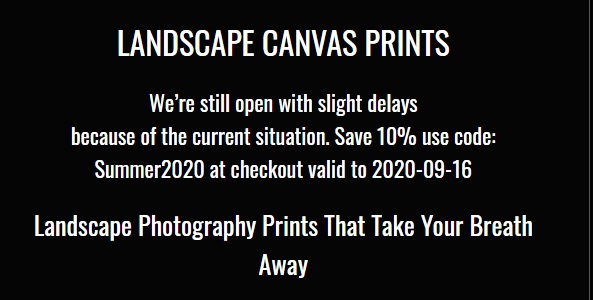Previously, receiving a portrait of yourself by hiring an artist was a thing that only the select classes could afford – it was costly and time consuming in the same time, not mentioning the long hours spent seating in front of a painter with out having the ability to move. These days you may take hundreds of digital photos, choose which one you like the most, the position, the colour, the background, even an effect, shop it within your mobile or digital camera and order a canvas print from it online. Really straightforward, quick and very affordable, but you will find various things to consider when ordering these style of prints. Get much more information about landscape canvas prints
Beneath is some background on approaches used when printing canvas prints from pictures: By far the most well-known form of canvas prints is named ‘inkjet art’ and involves using big format inkjet printers that use pigment archival inks for printing the picture on canvas components. The resolution of your resulting prints could be outstanding, the maximum being 2880x1440DPI (dots per inch) in the time of writing this article. The pigment is actually a distinct form of ink that guarantees both steady colour gamut representation and resistance for UV rays and other external factors like dust and moisture.
Cotton or Poly-Cotton Canvas?
The canvas might be either pure cotton or a mix among cotton and polyester, most canvas suppliers state on their websites which type of canvas they use. Typically the pure cotton canvas prints are much more pricey. The pure cotton canvas gives the print a additional natural look, the texture seems closer to the regular painting, whereas the poly-cotton mix provides the picture extra plastic or linen look look. After the picture is printed, the material is varnished and stretched on a stretcher frame, this can be a distinct sort of wooden timber frame that has wedges in every corner which enables you to re-tension ( re-stretch) the canvas material at anytime by pushing these wedges towards the frame’s corners. My assistance is the fact that you shouldn’t buy a canvas print that is certainly just sticked on a wooden panel, possessing it appropriately framed the classic way that includes stretching around the wedged timber frame ensures durability from the print, as the canvas could appear a little loose immediately after some time and you need these wedges to become in a position to re-stretch it once again.
What photographs are suitable for printing on canvas?
Photo Resolution: The high-quality on the canvas print is straight proportional together with the resolution of one’s photo. Frequently you shouldn’t submit a photo that has significantly less than 250KB, since it may well seem ‘pixelated’, even on a 10x10cm print. When choosing an online canvas shop ensure that their website features a photo checking tool, after you upload your photo the tool tells you no matter whether the resolution of your photo is appropriate for the canvas size you selected. When you know the dimensions of the photo (most Mac and Windows systems show this information inside the photo properties box) you may identify the resulting print resolution by dividing the number of pixels your photo has by the number of inches the canvas print size chosen by you has. By way of example if your photo has 5000 pixels horizontally, and you want a print that has a width of 50 centimeters, the resulting print will have about 5000pixels/20inches=250DPI horizontal resolution. The identical calculation applies to vertical resolution. A print that has a minimum of 250DPI, on canvas, is actually a relatively great hunting print. The calculation above represents the true resolution, nevertheless the specialist printers using many software can ‘enreach’ pictures that have decrease resolution, there are actually many algorithms that in fact enlarge a photo and boost the resolution in the similar time by artificially developing pixels, the resulting print nonetheless may present patterns like minor squares or circles.
Cropping or Resizing?
A very good online canvas print shop must present you the layout in the resulting canvas prior to you acquire. Since you will discover a number of aspect ratios that photographs have (4:3, 3:2 for example – the aspect ratio is number of pixels horizontally divided by number of pixels vertically), your photo might need to have some cropping and without the need of seeing what the designer is going to crop from your photo you naturally run the danger of receiving the print that you do not want. In case your photo has an aspect ratio of 3:2 and you select one example is an 40x30cm canvas, the photo might be either cropped or resized to that dimension. As described just before, if you order the website must provide you with the control and let you to crop or resize the photo the way you would like it to determine on the canvas.
Who takes the risk?
Canvas prints made from your photographs are classified as personalized goods, you must check the seller’s terms and conditions referring to returns and cancellations. Not all sellers will reprint your canvas unless is damaged. In contrast to with other products purchased online, where you have a distinct time period through with you’ll be able to test the item and return it if you never like it, with all the customized products the circumstance is diverse. The pure truth that you simply don’t just like the print does not offer you right away the proper to return it, so read cautiously the terms and circumstances from the seller. Even when they offer a return or refund in case the print arrives faulty, make sure that they describe just what a faulty item is. For example in case your picture is cropped within a different way than you expected- you’d take into consideration the print faulty, nevertheless the printer may argue and not recognize this as a fault.


